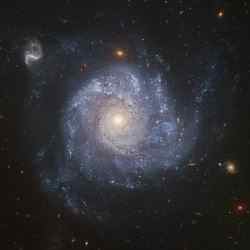
Spiral galaxy NGC 1309. Image credit: Hubble Click to enlarge
Looking like a child’s pinwheel ready to be set a spinning by a gentle breeze, this dramatic spiral galaxy is one of the latest viewed by NASA’s Hubble Space Telescope. Stunning details of the face-on spiral galaxy, cataloged as NGC 1309, are captured in this color image.
Recent observations of the galaxy taken in visible and infrared light come together in a colorful depiction of many of the galaxy’s features. Bright blue areas of star formation pepper the spiral arms, while ruddy dust lanes follow the spiral structure into a yellowish central nucleus of older-population stars. The image is complemented by myriad far-off background galaxies.
However, this galaxy image is more than just a pretty picture. It is helping astronomers to more accurately measure the expansion rate of the universe. NGC 1309 was home to supernova SN 2002fk, whose light reached Earth in September 2002. This supernova event, known as a Type Ia, resulted from a white dwarf star accreting matter from its companion in a binary star system. When the white dwarf collected enough mass and was no longer able to support itself, the star detonated, becoming the brightest object in the galaxy for several weeks.
Nearby Type Ia supernovae like SN 2002fk in NGC 1309 are used by astronomers to calibrate distance measures in the universe. By comparing nearby Type Ia supernovae to more distant ones, they can determine not only that the universe is expanding, but that this expansion is accelerating. However, this method only works if the distance to the host galaxies is known extremely well.
That’s where the Hubble Telescope comes into play. Since NGC 1309 is relatively close to us, the high resolution of Hubble’s Advanced Camera for Surveys can help accurately determine the distance to the galaxy by looking at the light output of a particular type of variable star called a Cepheid variable. Cepheids are well studied in our own galaxy, and vary regularly in brightness at a rate that is directly related to their total intrinsic brightness. By comparing their variation rate with how bright they appear, astronomers can deduce their distance. In this way, the Cepheids in NGC 1309 allow astronomers to accurately measure the distance to NGC 1309, and thus to SN 2002fk. The expansion of the universe was discovered by Edwin Hubble, the Hubble Space Telescope’s namesake, nearly a century ago, but the accelerating expansion is a recent discovery which has interesting consequences for cosmological models.
These Hubble images were taken in August and September 2005. NGC 1309 resides 100 million light-years (30 Megaparsecs) from Earth. It is one of about 200 galaxies that make up the Eridanus group of galaxies.
Original Source: Hubble News Release
